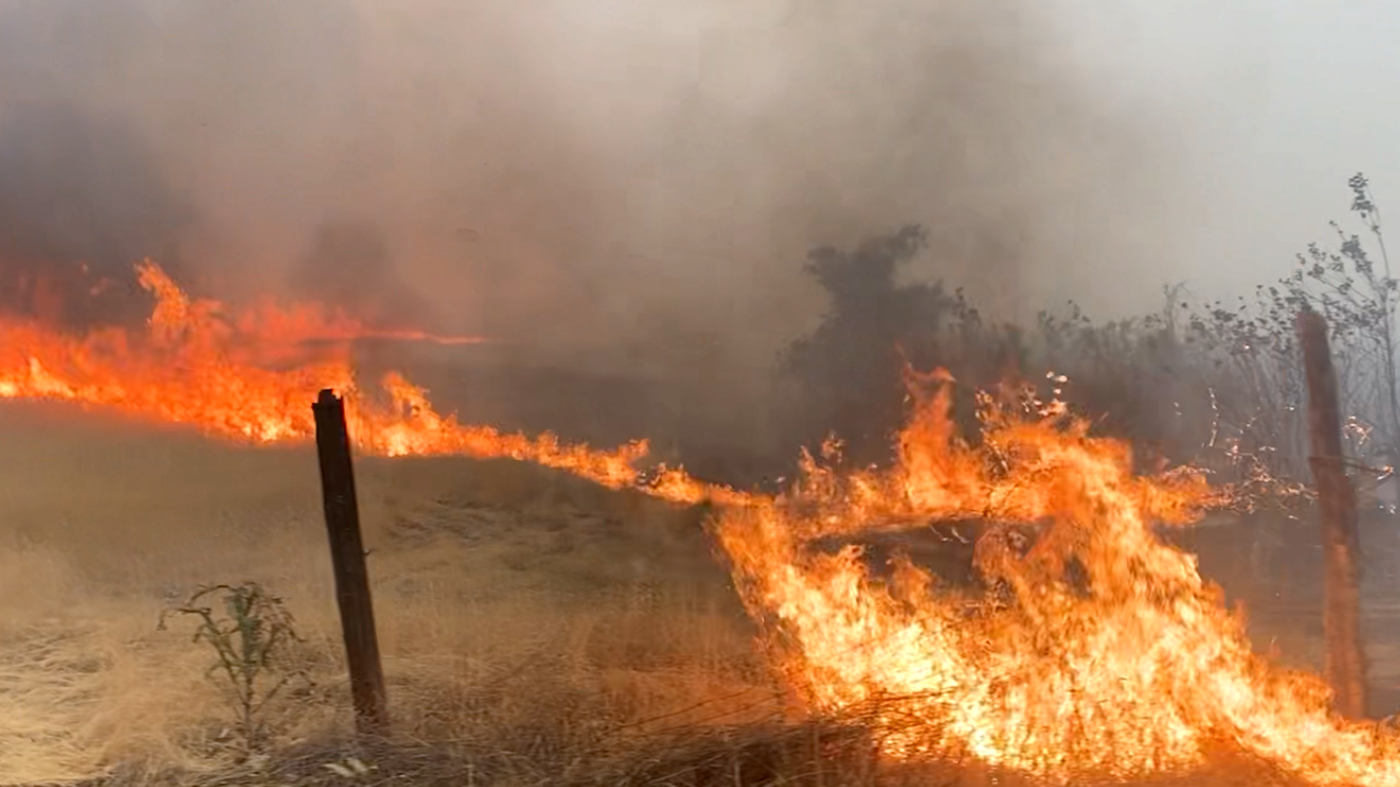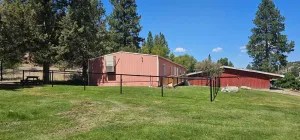Isaac ‘Ike’ Guker: Proprietor of the Great Northern Mine
Published 4:00 pm Sunday, January 26, 2003

- Ike Guker is at his cabin in Upper Quartz Gulch on Little Canyon Mountain in this photograph taken circa 1898. Guker walked across the American West when it was largely a wild country. Photo of Rosella Spahn
Isaac Guker was born 3 April 1860 in Moessingen, Wurttemberg – the Black Forest region of Germany. At the age of 3, his family immigrated to the United States, landing at Baltimore, Md. After visiting relation in New York City, they boarded a train bound for Ohio, but were detained three weeks near Philadelphia on account of the Battle of Gettysburg.
Trending
Ike grew up in Ohio and Indiana where he worked hard on the family farms. He thought his father was too demanding and so Ike left home, heading west about 1881. Ike sent his parents one letter and repaid a debt. He was in Dakota Territory for a time and the family attempted to locate him there, but he left no trail. They did not hear of him again for over 50 years!
Ike took to mining and worked throughout the west, from the Dakotas to California, and from Mexico to British Columbia. His many adventures included a run-in with cattle-barons’ goons during the Montana Range Wars when they set fire to his cabin, and a narrow escape from Apache bandits in Old Mexico, where he had to dig through a dirt floor in the middle of the night, then made his way to Arizona on foot!
From time to time, Ike visited with an old prospector named MacKay who encouraged him to try his pick at a place called “Canyon Mountain.” In Colorado, Ike ran into MacKay again and he described the district around Canyon City, Oregon. He said there was no hard-rock mining in the area. Here, Ike saw an opportunity. He entered Grant County in the fall of 1895. Recognizing that all the rich placer gold near Canyon City must have washed from initial sources, Ike began prospecting for the mother lode.
Trending
He built a log cabin on Little Canyon Mountain and devoted his efforts to the north face in 1896. He sampled along the base of the mountain, crawling over most of the terrain on his hands and knees. In later years, Ike claimed he could almost smell the gold. One thing is for certain: Ike was meticulous and very well suited for prospecting. In September 1896, he came to the crest of the ridge and dug a 25-foot discover shaft, staking one of the first hard-rock or “lode” claims in the district: The Great Northern.
He continued to prospect and high-grade around the area. In April 1898, he dug an open cut on the Great Northern and found a trace, then drove a tunnel. He picked and blasted, and after the dust settled, Ike found that he blew his way into a fabulous pocket! As he looked around the tunnel, picked up chunks of gold, he sat down and wept for joy. The pocket yielded about $67,000 in gold – when gold was about $12 an ounce. That gold would be worth over $1,500,000 today, and easily four times that as specimens! News of the strike sparked a small gold rush to Little Canyon and other places not previously prospected for lode deposits.
Of the Great Northern, The Sumpter News of 12 March 1898 reported: “…Most of the Gold is taken from a narrow vein of decomposed quartz laying between very hard walls. It is almost a solid mass of gold. … Three or four men only are working the claim and they take anywhere from $100 to $500 daily. Mr. Guker refused an offer the other day of $3,000 for what gold was in sight. … And Isaac isn’t stingy either. He presents a gold nugget to everyone who visits the claim and don’t work it on Sunday.”
Gold from the Great Northern runs 98 percent pure and is found as wires, meshed nuggets, and rare crystalline gold in both quartz and calcite. Specimens from the Great Northern Mine are among the finest in the world as was proved at several World Expositions where gold from the Great Northern received Gold, Silver, and Bronze medals.
Ike and a group of Salt Lake City capitalists incorporated the Great Northern Mining & Milling Co. He spent $5,000 to construct a grade ore road to the mine and improved the road all the way to Canyon City, according to a prospectus printed for the 1898 World’s Fair in Buffalo, N.Y. The mine had its own assay office and boasted a 20-man bunkhouse. The Great Northern Mine was patented in 1900 and was capitalized at $1,000,000. Unfortunately, the partners could not agree on a plan of operation or who would supply capital. As lawsuits ensued in 1903, the ore mill burned down and rumors flew of scuttled prospects. It was not until 1937 that a judge awarded Ike full and unencumbered ownership of the Great Northern.
Ike owned and developed scores of gold mines around Little Canyon, Dixie Creek, Susanville, Greenhorn and Sumpter. He also inspected mines for prospective buyers and contracted other work. The Iron King Mining & Milling Co. hired him to build the road to that chrome mine during World War I. Ike’s records show that 43 man-days of labor, 48 sticks of powder, 50 feet of fuse and 20 caps were spent in April, and about that much again in June 1918. (That ore road has commonly been called the Canyon Mountain Trail Road since the 1960s.)
A typical prospector, Ike worked hard and was ever an optimist. By 1925, he was 65 years old. On 15 May 1925, the Blue Mountain Eagle reported: “Ike Guker was drawn on the grand jury and for the week had to lay down his pick and pan. During the last few months he has single-handed and alone sunk a shaft 40 feet. He has a 10-quart bucket which he fills with muck, climbs the ladder and draws it up with a windlass and then down and repeats the operation. But ‘she’s panning good,’ says Ike, ‘and I will tap the vein where she freezes solid with yellow metal.’ And Ike Guker knows, for he has made a living on Canyon Mountain for 30 years and took out one bunch of high grade with $50,000 in it. ‘And there are more in the mountain,’ says Ike.”
When Ike was about 74 years old, he had lost most of his teeth but, surprisingly, he began to grow a third set! Mrs. Mary Grove of John Day happened to read a newspaper article of the event in 1934 and made a remarkable connection. Coincidentally, Mary Grove was a friend of Mrs. Rose (Gucker) Sand, Ike’s sister of Bucyrus, Ohio! Recognizing the uncommon name, or perhaps knowing that Rose’s eldest brother had left home years before, Mrs. Grove wrote a letter to Rose Sand. Rose immediately contacted her youngest brother, Dan Gucker, who was living in Kent, Wash. Dan drove to Canyon City in his ’32 Ford and located Ike near Canyon City, confirming that he was their long-lost sibling – indeed, Ike and Dan may never have known each other as Dan was 20 years Ike’s junior and born about the time Ike left home!
There was a great reunion. Many family members would visit the mines over the years and Ike returned to see relation in Ohio and Indiana. Ike continued to mine on Little Canyon Mountain for another decade, often hiking a mile or two from his cabin to a prospect. Ike Guker died at Blue Mountain Hospital in Prairie City 4 June 1947, aged 87 years. His body is buried at Canyon City Cemetery where there is a fine view of the Great Northern Mine.
Isaac Guker lived a full life, walking across the American West when it was largely a wild country. His adventures made him a rich man, even without color in his pan. He acquired and lost fortunes, giving away the majority of his gold. Specimens of Ike’s gold are publicly displayed at the US Bank in Baker City and the Grant County Historical Museum in Canyon City. He lived as a bachelor and was a loving brother and uncle following the reunion with his family after their extended separation. In politics, he was Republican. In religion, he was an earnest Christian. Ike practiced an honest work ethic, prospecting and mining in Grant County for over half a century.
Nick Sheedy of John Day is the great-great-great nephew of Isaac Guker.









